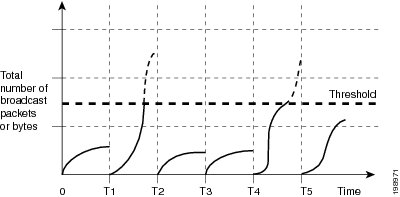Configuring Traffic Storm Control
Available Languages
Contents
Configuring Traffic Storm Control
This chapter describes how to configure traffic storm control on Cisco Nexus 5000 Series switches. It contains the following sections:
- Information About Traffic Storm Control
- Traffic Storm Guidelines and Limitations
- Configuring Traffic Storm Control
- Traffic Storm Control Example Configuration
- Default Traffic Storm Settings
Information About Traffic Storm Control
A traffic storm occurs when packets flood the LAN, creating excessive traffic and degrading network performance. You can use the traffic storm control feature to prevent disruptions on Ethernet interfaces by a broadcast, multicast, or unknown unicast traffic storm.
Traffic storm control (also called traffic suppression) allows you to monitor the levels of the incoming broadcast, multicast, and unicast traffic over a 10-microsecond interval. During this interval, the traffic level, which is a percentage of the total available bandwidth of the port, is compared with the traffic storm control level that you configured. When the ingress traffic reaches the traffic storm control level that is configured on the port, traffic storm control drops the traffic until the interval ends.
The following figure shows the broadcast traffic patterns on an Ethernet interface during a specified time interval. In this example, traffic storm control occurs between times T1 and T2 and between T4 and T5. During those intervals, the amount of broadcast traffic exceeded the configured threshold.
The traffic storm control threshold numbers and the time interval allow the traffic storm control algorithm to work with different levels of packet granularity. For example, a higher threshold allows more packets to pass through.
Traffic storm control on the Cisco Nexus 5000 Series switch is implemented in the hardware. The traffic storm control circuitry monitors packets that pass from an Ethernet interface to the switching bus. Using the Individual/Group bit in the packet destination address, the circuitry determines if the packet is unicast or broadcast, tracks the current count of packets within the 10-microsecond interval, and filters out subsequent packets when a threshold is reached.
Traffic storm control uses a bandwidth-based method to measure traffic. You set the percentage of total available bandwidth that the controlled traffic can use. Because packets do not arrive at uniform intervals, the 10-microsecond interval can affect the operation of traffic storm control.
The following are examples of how traffic storm control operation is affected:
If you enable broadcast traffic storm control, and broadcast traffic exceeds the level within the 10-microsecond interval, traffic storm control drops all broadcast traffic until the end of the interval.
If you enable multicast traffic storm control, and the multicast traffic exceeds the level within the 10-microsecond interval, traffic storm control drops all multicast traffic until the end of the interval.
If you enable broadcast and multicast traffic storm control, and broadcast traffic exceeds the level within the 10-microsecond interval, traffic storm control drops all broadcast traffic until the end of the interval.
If you enable broadcast and multicast traffic storm control, and multicast traffic exceeds the level within the 10-microsecond interval, traffic storm control drops all multicast traffic until the end of the interval.
By default, Cisco NX-OS takes no corrective action when the traffic exceeds the configured level.
Traffic Storm Guidelines and Limitations
When configuring the traffic storm control level, follow these guidelines and limitations:
You can configure traffic storm control on a port-channel interface.
Specify the level as a percentage of the total interface bandwidth:
Because of hardware limitations and the method by which packets of different sizes are counted, the level percentage is an approximation. Depending on the sizes of the frames that make up the incoming traffic, the actual enforced level might differ from the configured level by several percentage points.
Configuring Traffic Storm Control
SUMMARY STEPSYou can set the percentage of total available bandwidth that the controlled traffic can use.
Note
Traffic storm control uses a 10-microsecond interval that can affect the operation of traffic storm control.
2. switch(config)# interface {ethernet slot/port | port-channel number}
3. switch(config-if)# storm-control {broadcast | multicast | unicast} level percentage[.fraction]
DETAILED STEPS
Command or Action Purpose Step 1 switch# configure terminal
Enters configuration mode.
Step 2 switch(config)# interface {ethernet slot/port | port-channel number}
Enters interface configuration mode.
Step 3 switch(config-if)# storm-control {broadcast | multicast | unicast} level percentage[.fraction]
Configures traffic storm control for traffic on the interface. The default state is disabled.
Verifying Traffic Storm Control Configuration
To display traffic storm control configuration information, perform one of these tasks:
Command
Purpose
switch# show interface [ethernet slot/port | port-channel number] counters storm-control Displays the traffic storm control configuration for the interfaces.
Note Traffic storm control uses a 10-microsecond interval that can affect the operation of traffic storm control.
switch# show running-config interface Displays the traffic storm control configuration.
Contact Cisco
- Open a Support Case

- (Requires a Cisco Service Contract)


 Feedback
Feedback